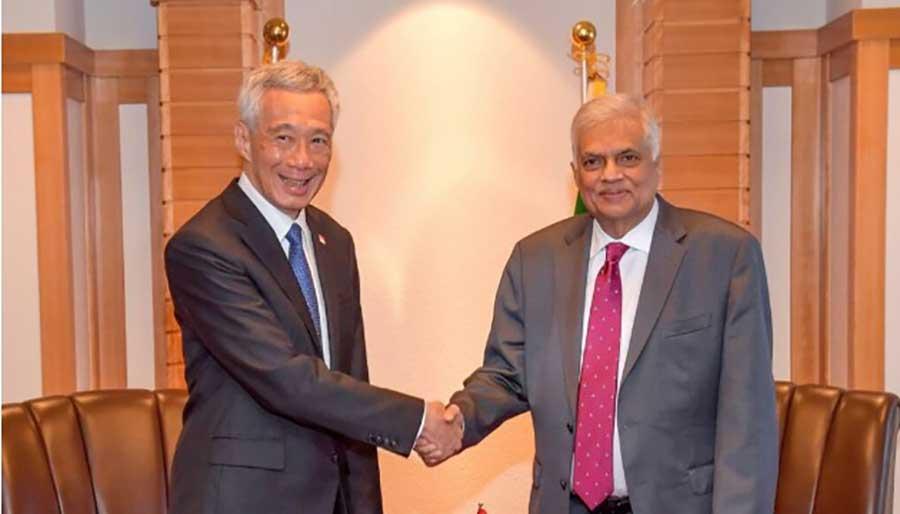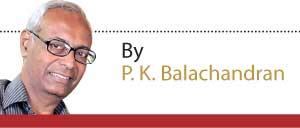Reply To:
Name - Reply Comment
Last Updated : 2024-05-18 20:50:00

Lee Hsien Loong with Ranil Wickremesinghe
Beneficial as it may be, the political and economic conditions in Sri Lanka now are not conducive for the SLSFTA
Sri Lankan President Ranil Wickremesinghe told Singapore’s Prime Minister Lee Hsien Loong in Tokyo on Tuesday, that Sri Lanka would give priority to reviving the Sri Lanka-Singapore Free Trade Agreement (SLSFTA) of 2018. The SLSFTA, which was signed when Wickremesinghe was Prime Minister, became operational on May 1, 2018, but only to be disregarded by the end of the year following a recommendation of a Presidential Commission of Inquiry (PCoI) that it should be re-negotiated.
Tuesday, that Sri Lanka would give priority to reviving the Sri Lanka-Singapore Free Trade Agreement (SLSFTA) of 2018. The SLSFTA, which was signed when Wickremesinghe was Prime Minister, became operational on May 1, 2018, but only to be disregarded by the end of the year following a recommendation of a Presidential Commission of Inquiry (PCoI) that it should be re-negotiated.
While the promise of revival of the moribund pact may please the Singaporean Prime Minister, Wickremesinghe would find it very difficult to carry out his promise because the political and economic conditions in Sri Lanka are not yet conducive for the SLSFTA.
In fact, they are worse than they were in 2018. Firstly, the opposition is questioning the legitimacy of Wickremesinghe’s Presidency and the country itself is preoccupied with finding a way out of an unprecedented economic crisis. The objections raised by the political and business communities in 2018, will be raised again.
The Sri Lankan business community opposed the SLSFTA fearing extinction due to an inability to withstand competition from Singaporean goods and services. The Professionals’ National Front (PNF) had urged President Maithripala Sirisena to revoke the SLSFTA and take steps to prepare a National Trade Policy first.
In April 2021, the next government led by Gotabaya Rajapaksa appointed a 21-member National Negotiation Committee (NNC) to go into Sri Lanka’s pending FTAs, including the SLSFTA. That committee recommended 18 amendments to the SLFTA.
However, nothing was done as a follow-up as Sri Lanka had by then rapidly slid into an unprecedented economic crisis marked by an acute shortage of foreign exchange. Even the successor government led by Wickremesinghe himself could not do anything because of an exacerbation of the political and economic crises.
Be that as it may, President Wickremesinghe himself has long-term plans to make the Lankan economy a hub in the Indian Ocean. As part of this plan, he is for closer trade and investment relations with South and South East Asia, particularly India, Singapore, Japan and ASEAN. Hence his interest in reviving the SLSFTA.
Trade Figures
According to Singaporean sources, Singapore’s imports from Sri Lanka stand at Singapore $ 178 million while Singapore’s exports to Sri Lanka are worth Singapore $ 2.5 billion. Bilateral trade between Singapore and Sri Lanka grew at an average rate of 7% annually from 2005 to 2015. Singapore is Sri Lanka’s fourth-largest investor followed by China, Hong Kong, and India. Singapore’s FDI accounted for 5.3% of Sri Lanka’s GDP between 2014 and 2017.
Key Features of SLSFTA
According to Janaka Wijayasiri and Kithmina Hewage of the Colombo-based Institute of Policy Studies, the key features of the SLSFTA are: “Customs duties on 50% of tariff lines are to be eliminated immediately by Sri Lanka (approximately 3600 tariff lines). This would be gradually increased to 80 % over a period of 12 years. Singapore already grants Sri Lanka tariff free-access on 99% of goods. All goods under the agreement would have to fulfill Rules of Origin (ROO) of 35% Domestic Value Addition (DVA). For some export products, specific process rules will apply. No ASEAN cumulation would be allowed under the FTA.”
 “Sri Lanka’s Negative List would account for 20 % of the country’s tariff lines and contains sensitive items based on revenue and domestic considerations (i.e., petroleum products, alcohol and tobacco). Under the agreement, international standards and practices have been adopted to reduce non-tariff measures impeding trade.”
“Sri Lanka’s Negative List would account for 20 % of the country’s tariff lines and contains sensitive items based on revenue and domestic considerations (i.e., petroleum products, alcohol and tobacco). Under the agreement, international standards and practices have been adopted to reduce non-tariff measures impeding trade.”
“There would be better access to service sector markets in Singapore and Sri Lanka, with liberalization across different modes of trade in services, in sectors such as professional and trade-related services, environmental services, construction, and tourism. Movement of natural persons would be linked to commercial presence (e.g., intra-corporate transferees). Only Singaporean and Sri Lankan nationals would be recognized under the Agreement.”
“The chapter on investment provides a binding commitment and framework guaranteeing predictability and transparency for investors. Government procurement (GP) is included in the agreement, ensuring Sri Lankan businesses can compete with Singapore businesses for government contracts. This is the first time Sri Lanka has included GP in its trade agreements. There will be reduced business costs and red tape around customs processing, competition law, and technical and quarantine standards. There will be a clear process to settle disputes.”
Plus Points
Wijayasiri and Hewage say that there are two compelling arguments supporting the SLASFTA. “At the bilateral level, it provides reciprocal benefits for both countries. It will enhance bilateral trade, improve the economic and investment relationship, and provide more secure and open access for goods, services, and investments in Sri Lanka and Singapore. But more importantly, it will help Sri Lanka advance the government’s policy of trade liberalization, and signal its commitment to economic reforms.”
“The FTA is also expected to encourage greater investment flows between the two countries. Singapore sees potential in Sri Lanka as a destination for Singaporean investments and a gateway to rest of South Asia, given the proximity to and trade agreements with countries in the South Asian region.”
“At the regional level, the agreement serves Sri Lanka’s broader engagement with one of the fastest growing regions in the world – ASEAN. Stronger relations with Singapore can help Sri Lanka’s standing in South-East Asia and participation in global value chains.”
Need for New Outlook and Safeguards
If Wickremesinghe is to implement the SLSFTA, he would have to consider the report of the W.D.Lakshman committee which sought a re-negotiations and also the 18 amendments sought by the National Negotiating Committee of April 2021. One of the major complaints against the government in 2018 was that it entered into the SLSFTA without consulting all the stakeholders. Government has to take the path of wide consultations before inking any fresh agreement.
This task is not going to be easy as the left parties and also the middle-of-the-road Samagi Jana Balawegaya (SJB) have heightened their nationalistic posture with an eye on the coming elections. They are also constantly threatening to hit the streets in protest. Since their basic aim is to dethrone the “illegitimate Wickremesinghe-Rajapaksa” government, they would use any stick to beat the government with including the SLSFTA.
Jayapala Handunwatta Wednesday, 05 October 2022 05:30 AM
Shameless RW is destroying the image of SL!! Once his PM called him a Big Bank Robber; now what? Pin Gona wasting public money without any power given by people, but 134 crooks!! 134 are well off now!!
lion Friday, 07 October 2022 04:40 AM
SNGAPPORIAN PRIMINISTER SHOULD HAVE Avoided hand shaking with this Srilankan fake precedent, rather the leader of 134 corrupt M.P. s in the Parliament.

Add comment
Comments will be edited (grammar, spelling and slang) and authorized at the discretion of Daily Mirror online. The website also has the right not to publish selected comments.
Reply To:
Name - Reply Comment
The state-run loss-making State Mortgage & Investment Bank (SMIB) has reveale
US authorities are currently reviewing the manifest of every cargo aboard MV
On March 26, a couple arriving from Thailand was arrested with 88 live animal
According to villagers from Naula-Moragolla out of 105 families 80 can afford
17 May 2024 - 0 - 112